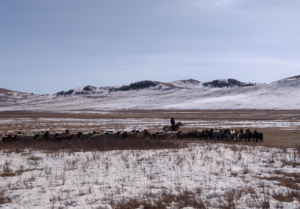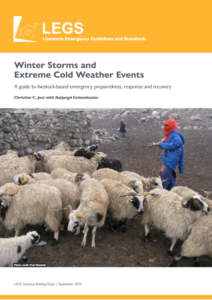LEGS is pleased to announce the launch of a new technical brief focusing on the application of the Livestock Emergency Guidelines and Standards (LEGS) in the context of winter storms and extreme cold weather events in Asia.
Authored by Christine Jost with Batjargal Erdenebaatar, this vital resource is designed to equip users with knowledge, practical strategies, and best practices in response planning and delivery for livestock-dependent communities that are vulnerable to severe winter emergencies.
The brief is available in English, Spanish and Arabic and was accompanied by an explanatory webinar, held on 23rd October at 09:30 BST.
Livestock Livelihoods and the Impact of Severe Winter Weather

© David Hadrill
In the cold and mountainous regions of Asia, rural communities often rely heavily on livestock for both food and income, as the harsh climate limits other forms of agriculture. Extreme winter storms, blizzards, and prolonged cold spells pose significant threats to these livestock-based livelihoods, leading to increased mortality, reduced productivity, and overall economic distress. Ensuring that communities are adequately prepared to face such challenges is crucial for maintaining their livelihoods and resilience.
Key Features of the Technical Brief
The newly published brief provides LEGS-based guidance to help strengthen preparedness and response efforts for communities facing extreme winter conditions. It delivers comprehensive information on good practices and strategies for effective response planning, specifically tailored for livestock-dependent households in regions susceptible to harsh winter storms. The brief delves into:
- Good Practice Guidance for Preparedness and Response: Practical steps to protect and support livestock during severe winter conditions, incorporating insights and techniques from LEGS.
- Case Studies and Documented Evidence: While documented examples of LEGS application in Mongolia highlight the effectiveness of these guidelines, evidence from other Asian countries remains limited. This brief aims to bridge that gap by sharing lessons learned and demonstrating how LEGS can be adapted to different contexts.
- Exploring Past and Future Responses: The document draws on past responses to winter storms and extreme cold weather, using these experiences to illustrate how future applications of LEGS can safeguard livestock and improve community resilience.
Watch Our Webinar for More In-Depth Insights
To further explore how LEGS can be applied to bolster preparedness and resilience in communities affected by extreme cold weather, we invite you to watch our Winter Storms and Extreme Cold Weather Webinar.
The webinar took place on 23rd October at 09:30 BST, offering an opportunity to dive deeper into the findings of the technical brief and engage with experts on how best to apply LEGS in challenging winter conditions.
Whether you are a practitioner, policymaker, or community member involved in disaster risk reduction for livestock-dependent areas, this session will provide valuable insights and practical tools for making a real difference.
Featured speaker:
 Dr. Christine C. Jost is a veterinarian with extensive experience in global health, humanitarian assistance, and veterinary education, currently consulting for USAID’s Global Health Bureau. She is also a LEGS trainer, participatory epidemiology master trainer, and certified Holistic Management educator.
Dr. Christine C. Jost is a veterinarian with extensive experience in global health, humanitarian assistance, and veterinary education, currently consulting for USAID’s Global Health Bureau. She is also a LEGS trainer, participatory epidemiology master trainer, and certified Holistic Management educator.
Equip yourself with the knowledge and guidance needed to safeguard livestock livelihoods and support vulnerable communities during extreme winter events.


